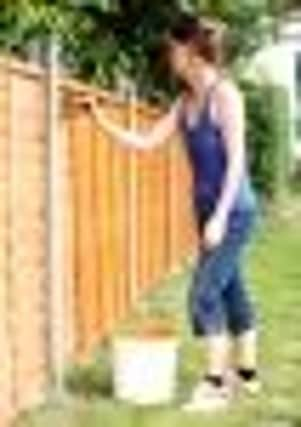Ideal time for a garden makeover


Getting a landscape gardener in tends to be expensive, often costing thousands of pounds, but for those on a budget there are lots of relatively easy and inexpensive ways to transform your outside space.
If you have a courtyard, bare brick walls can look drab and boring, but paint will transform them in no time.
Advertisement
Hide AdAdvertisement
Hide AdSandtex does a striking exterior Feature Wall range, but if you’re not that adventurous, painting the walls white will make a massive difference - they’ll be lighter, brighter and cheerier.
To seal walls before painting them, use a stabilising solution such as Dulux Trade Weathershield Stabilising Primer which does a good job of stabilising powdery and chalky walls.
There’s nothing worse than dilapidated fences, so repair or replace broken ones. If you’re starting from scratch, fence panels are the quickest option because each panel covers a large area, but closeboard fencing, where you build up the fence with single vertical boards, is more durable and bespoke.
Finish off with a lick of fence paint - it’s much smarter and more modern than boring brown wood stain. For nature-inspired colours, including some gorgeous blues and greens, check out Ronseal’s Woodland Colours range, with a donation from sales made to the Woodland Trust.
Advertisement
Hide AdAdvertisement
Hide AdFences can, of course, be softened with plants, but if you think that only a hedge will do, look for shrubs that grow fast, such as (notoriously vigorous) leylandii, or go for a ready-made hedge (available by the metre), which is a really costly but instant option.
Hedges are better windbreaks than a solid barrier, although not as secure if you have kids and/or pets. Hedges also filter noise from roads/neighbours, provide natural beauty, encourage wildlife, increase security (if prickly) and tend to be longer lasting and more weather resistant than fences.
Once you’ve done the boundary, a garden isn’t much good without an entertaining area.
For a quick fix, use bags of gravel, pebbles or slate chips to cover up unsightly concrete or paving.
Advertisement
Hide AdAdvertisement
Hide AdTiles are a more attractive, practical and permanent solution. Some floor tiles are suitable for exterior use, including slate and frost-resistant ceramic ones, but getting the ground level can be tricky.
You’ll need to prepare it well and build up the adhesive to make the tiles as level as possible - or get a tiler to do it.
Good old paving slabs provide a more traditional look. Bog-standard slabs are a budget choice, while stone and concrete imitations of stone are nicer but more expensive.
To add interest to your patio, combine different-sized slabs or tiles, or incorporate patterns like circles, which are available as kits.
Advertisement
Hide AdAdvertisement
Hide AdThink a patio’s a bit past it? Decking is more contemporary and warm to the touch, plus it can hide eyesores like concrete and, if raised, can be used to level out sloping or uneven ground. Choose from decking kits or individual boards.
For lots of people, a garden wouldn’t be a garden without a lawn, but grass is easy to damage and kill off. For repair and replacement, the most popular options are turf and grass seed.
Turf provides a pretty much instant lawn, but it needs to be laid (from early autumn to late spring) the day you get it and is more expensive than seed.
Make sure you get good quality turf raised from seed (rather than meadow turf) from a reputable supplier, and order at least five per cent more than you need.
Advertisement
Hide AdAdvertisement
Hide AdGrass seed (best sown from April to May or September to early October) takes a couple of months to establish - when it can’t be walked on - and is more vulnerable to the weather and birds than turf.
For the best result, sow ten per cent more than is recommended and choose a type of seed suitable for your garden and lifestyle - families with kids, for example, need hard-wearing varieties.